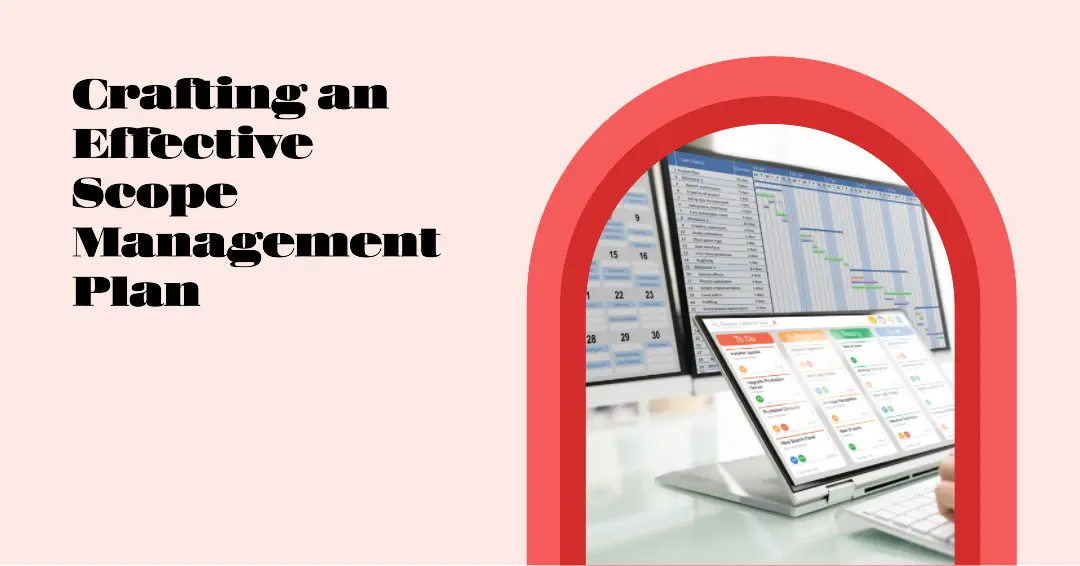I. Introduction
Picture this: You’ve just been assigned to lead a new, exciting project at work. You’re eager to dive in and start making things happen. But before you can even begin, you realize there’s a crucial element you need to tackle – creating a scope management plan. It might not sound like the most thrilling task, but trust me, it’s the foundation that sets your project up for success.
As someone who has managed numerous projects, I’ve learned the hard way that a well-defined scope management plan is essential to keep things running smoothly. It’s the backbone of your project, outlining its boundaries and ensuring everyone involved is on the same page. In this blog post, I’ll walk you through the art of crafting an effective scope management plan that will not only impress your stakeholders but also make your life as a project manager much easier.
So, are you ready to become a scope management maestro? Let’s get started!
II. Understanding the basics of a scope management plan
Before we dive into the nitty-gritty of creating a scope management plan, let’s take a step back and explore its fundamentals. Having a solid grasp of these basics will make the whole process smoother and more effective.
A. Definition of scope management
In simple terms, scope management is the process of defining, controlling, and managing the work needed to complete a project. It’s like drawing the boundaries of a sandbox – you’re establishing the limits of what’s included in your project and what’s not. This helps to prevent misunderstandings, keeps your team focused, and ultimately sets the stage for a successful outcome.
B. Purpose and objectives of a scope management plan
A well-crafted scope management plan serves several essential purposes:
- Clarity: It provides a clear understanding of the project’s goals, objectives, and deliverables for all stakeholders.
- Alignment: It ensures that everyone involved – from team members to top-level executives – is on the same page and working towards the same goals.
- Control: It helps you manage potential scope creep (we’ll discuss this in more detail later) and keep the project on track.
C. Key elements and stakeholders involved
While each project is unique, there are some common elements that every scope management plan should include:
- Project boundaries: Clearly define what’s in and out of scope.
- Deliverables: List the tangible outputs your project will produce.
- Constraints: Identify any limitations, such as time, budget, or resources.
- Assumptions: Note any factors you’re assuming to be true for the project to succeed.
As for stakeholders, they’re the individuals or groups who have a vested interest in your project. This can include team members, managers, clients, and even end-users. Involving them in the scope management process is crucial for getting buy-in and ensuring everyone’s expectations are met.
Now that we’ve got a solid understanding of scope management and its importance, let’s move on to the step-by-step guide to crafting an exceptional scope management plan that will keep your project on track and your stakeholders happy.
III. Step-by-step guide to creating a scope management plan
Ready to dive into the art of crafting an effective scope management plan? Follow these steps to create a plan that clearly defines your project’s boundaries and keeps everyone aligned.
A. Step 1: Define the project scope
- Gather requirements from stakeholders: Start by having conversations with your stakeholders to gather their input and expectations. Organize meetings, workshops, or brainstorming sessions, and don’t forget to ask probing questions. This will help you understand what they truly need and allow you to create a project scope that reflects their desires.
- Identify project boundaries and constraints: After gathering the requirements, it’s time to set the boundaries of your project. Determine what’s in scope and, just as importantly, what’s out of scope. Be as specific as possible and also identify any constraints, such as budget, timeline, or available resources.
- Establish project goals and objectives: Clearly define the goals and objectives of your project. These should be SMART (Specific, Measurable, Achievable, Relevant, and Time-bound) to ensure they are focused and achievable.
B. Step 2: Develop a work breakdown structure (WBS)
- Break down the project into smaller, manageable tasks: The WBS is a visual representation of your project, broken down into smaller tasks. It helps you see the big picture and makes the project more manageable. Start by identifying the major deliverables and then break them down into smaller tasks.
- Assign responsibility for each task: For each task in your WBS, assign a responsible party. This not only ensures accountability but also helps team members understand their roles and responsibilities.
- Estimate time and resources required: For each task, estimate the time and resources needed to complete it. This will help you create a realistic timeline and allocate resources appropriately.
C. Step 3: Establish a scope baseline
- Document the project scope statement: The project scope statement is a comprehensive document that includes all the elements you’ve gathered so far – project boundaries, goals, objectives, deliverables, and constraints. This will serve as the foundation for your scope management plan.
- Review and approve the scope baseline: Share the project scope statement with your stakeholders and get their approval. This ensures that everyone is on board with the defined scope before you move forward.
D. Step 4: Implement scope change control processes
- Develop a change control process: Changes are inevitable in any project. To manage them effectively, establish a change control process that outlines how scope changes will be identified, evaluated, and approved.
- Define roles and responsibilities for managing scope changes: Clearly assign roles and responsibilities for managing scope changes to ensure accountability and smooth execution.
- Establish a change request system: Implement a system for stakeholders to submit change requests, allowing you to evaluate and approve or reject changes in an organized manner.
E. Step 5: Monitor and control project scope
- Regularly review project progress: Periodically review your project’s progress to ensure it’s on track and aligned with the scope baseline. This helps you identify any deviations early on and address them promptly.
- Identify and manage scope creep: Scope creep occurs when small, uncontrolled changes accumulate and cause the project to veer off course. Be vigilant in identifying and managing scope creep to keep your project on track.
- Update scope baseline as necessary: When scope changes are approved, update your scope baseline accordingly. This ensures that your project documentation remains accurate and up-to-date.
By following these steps, you’ll be well on your way to crafting a comprehensive and effective scope management plan that sets your project up for success. But there’s more to it than just the process – communication plays a crucial role too. Let’s explore some tips for effective communication with stakeholders in the next section.
IV. Tips for effective communication with stakeholders
When it comes to crafting a solid scope management plan, communication is key. The best plan in the world won’t do you much good if your stakeholders aren’t on board or aren’t kept informed. Here are some tips I’ve picked up along the way to help you communicate effectively with your stakeholders:
A. Establish clear channels of communication
One of the first steps in setting up your project for success is to establish clear communication channels. This could include regular meetings, email updates, or a project management tool where everyone can track progress and collaborate. Choose the methods that work best for your team and stakeholders, and be consistent in your communication.
B. Regularly update stakeholders on project progress
Keep stakeholders in the loop by providing regular updates on project progress. This helps to build trust, manage expectations, and prevent any surprises down the line. Whether it’s through weekly status meetings or monthly progress reports, make sure you’re sharing information about completed tasks, upcoming milestones, and any potential issues that may impact the project scope.
C. Encourage stakeholder involvement and feedback
One of the most valuable assets in your project is the expertise and insights of your stakeholders. Make sure you’re tapping into that resource by actively involving them in the scope management process. Seek their input, listen to their concerns, and be open to their feedback. This not only helps to ensure you’re meeting their needs but also fosters a sense of ownership and commitment among stakeholders.
By incorporating these communication tips into your scope management plan, you’ll be able to build strong relationships with stakeholders, maintain alignment, and improve overall project success. However, even with the best communication practices, challenges and pitfalls may still arise in scope management. Let’s discuss some of these in the next section.
V. Common challenges and pitfalls in scope management
Throughout my years of managing projects, I’ve encountered my fair share of challenges when it comes to scope management. In this section, I’ll share some common pitfalls and offer advice on how to avoid or overcome them.
A. Misunderstandings between stakeholders
When multiple stakeholders are involved in a project, misunderstandings can arise, leading to misaligned expectations and potential conflicts. To avoid this, invest time in clearly defining the project scope and engaging in open communication with all stakeholders. Make sure everyone understands the project’s objectives, deliverables, and constraints, and don’t hesitate to revisit these topics if confusion arises.
B. Inadequate resources or time allocation
One of the most common challenges in scope management is underestimating the resources and time required to complete the project. This can lead to delays, cost overruns, and overall project failure. To mitigate this risk, be thorough in your planning, and gather input from team members and stakeholders to ensure your estimates are accurate. Additionally, build some contingency into your project schedule and budget to account for unforeseen changes or challenges.
C. Scope creep and its impact on the project
Scope creep is the silent killer of many projects – those small, incremental changes that add up and ultimately derail your project. It’s important to be vigilant in identifying and managing scope creep to keep your project on track. Here are a few strategies to help you tackle scope creep:
- Stick to your change control process: Remember the change control process you established in Step 4? Stick to it! Evaluate each proposed change and its potential impact on the project before approving or rejecting it.
- Maintain open communication: Keep stakeholders informed about the potential consequences of scope changes, and discuss the trade-offs before making decisions.
- Be proactive: Monitor project progress regularly and identify any deviations from the scope baseline early on. Address issues promptly to prevent them from spiraling out of control.
By being aware of these common challenges and taking steps to mitigate them, you’ll be better equipped to maintain control over your project’s scope and ultimately achieve success. As we wrap up this guide, let’s recap the importance of a scope management plan and offer some encouragement for applying these steps and tips in your projects.
VI. Conclusion
As we reach the end of our journey through the art of crafting an effective scope management plan, I hope you’re feeling inspired and better equipped to tackle your next project. We’ve covered the importance of a well-defined scope management plan, delved into the basics, and walked through a step-by-step guide to creating a plan that keeps your project on track and stakeholders aligned.
But remember, the learning doesn’t stop here. Each project is unique, and with every new challenge, you’ll gain valuable insights and experiences that will help you grow as a project manager. So, don’t be afraid to apply the outlined steps and tips, and adapt them as necessary to suit your specific projects.
Lastly, I’d like to invite you, my fellow project management enthusiasts, to share your own experiences and insights in the comments below. Have you faced any unique challenges in scope management? What strategies have you found most effective in keeping your projects on track? Let’s keep the conversation going and learn from one another.
Here’s to your success in mastering the art of crafting an effective scope management plan! Happy project managing!
To find out how Artificial Intelligence is changing the Project Management landscape, you have enjoy reading this article https://www.shaunstoltz.com/did-artificial-intelligence-just-change-everything-about-project-management/
Find out more about Shaun Stoltz https://www.shaunstoltz.com/about/
This post was written by an AI and reviewed/edited by a human.



